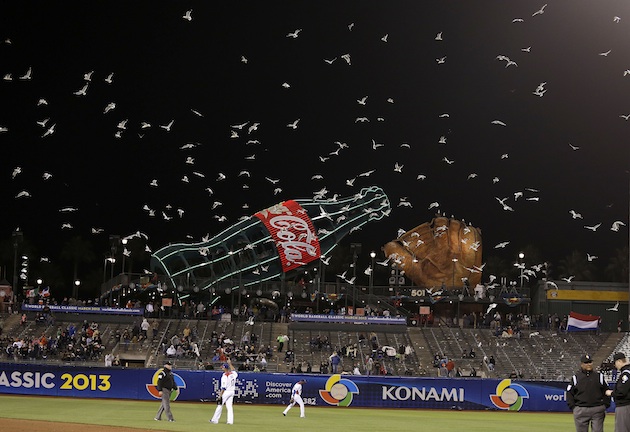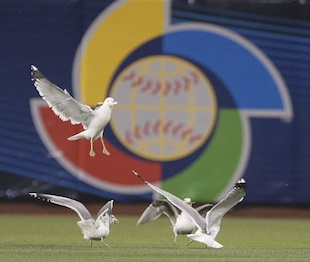
SAN FRANCISCO — The arrival of hundreds of seagulls in the eighth and ninth innings of a San Francisco Giants game is not an uncommon sight at AT&T Park. The birds have become such a big problem that they've earned their own parody Twitter account and the team has investigated several solutions to drive them from the park's site in the city's China Basin, including a red-tailed hawk named Bruce Lee.
None of the ideas, however, have completely worked and the birds keep arriving to feast on discarded hot dogs and the crusty remnants of bread bowls from clam chowder soup. This makes sense during the season, of course, but how did the gulls know to arrive during the eighth inning of of Monday's World Baseball Classic semifinal and steal the show from the game being played by the Dominican Republic and the Netherlands?
It's indeed remarkable the birds knew to arrive when they did considering that it had been 143 days between the last Giants home game (Game 2 of the World Series on Oct. 25) and the first WBC semifinal on Sunday. What's also worth noting is that Monday's first pitch was thrown just after 6 p.m. local time, a full hour before the first pitch of the typical Giants game.
Translation: This wasn't just a simple matter of routine, the birds knew exactly what was going on despite having the entire winter off.
So how did the seagulls know when to hit their mark on Monday? It's a question that was addressed by Lauren Sommer of KQED two seasons ago. According to her interviews of several gull experts, the birds use several cues to know when it's time to eat, including smell (the preparation of the stadium's famous garlic fries), sounds ("Take Me Out To the Ballgame" is a convenient marker) and movement (the late-innings exit of those in the upper deck looking to beat the crowds down the ramps).
Here's what David Shuford, a PRBO Conservation Science biologist, told KQED in 2011:
"Gulls spend their day cruising around a lot. But once they figure something out, they tend to come back. So even though the ninth inning doesn't happen at the same time each day, once a few gulls pick up on it, you'll soon have a crowd. It's possible that they can recognize the sounds, too, like songs that are played during the game. Gulls are pretty good about sound.
"In general, they're really good at figuring things out. Like when local dumps are closed on the weekends, the gulls seem to know that and don't show up on those days. It's hard to know if they truly know what Saturday is. They may just be cruising by and not see any action, so they don't land. But they seem to recognize the pattern."
 And here's what Jorge Costa, AT&T Park's senior VP for ballpark operations, said:
And here's what Jorge Costa, AT&T Park's senior VP for ballpark operations, said:
"It's a series of triggers that tells them it's time. They see the lights and the crowds. There are food smells, like the garlic fries. It's a combination of all those things. You'll see the gulls line up on the left field roof before the game ends. We see the scouts come in and they cue the rest of the gulls. It's a nuisance, really, and the fans don't enjoy it."
Despite the commotion and noises from above, Dominican Republic reliever Fernando Rodney was able to get through the distraction just fine on Monday night, pitching a perfect ninth inning and sending his country to its first World Baseball Classic final with a game-ending strikeout of Jonathan Schoop.
But the birds remained undeterred, too, sticking around during a noisy celebration from the Dominican Republic team and its fans and then through some high-volume hawk calls that were broadcast over the AT&T Park sound system. Nothing was going to keep them from the feast they had shown up for, just like nothing will keep them from doing the same thing after Tuesday night's title game — and then for the 81 Giants games after that.
Are you ready for baseball season?
Follow @bigleaguestew, @KevinKaduk and the BLS Facebook page!
No comments:
Post a Comment